For up-to-date publication information, please visit Prof. Kim’s Google Scholar page.
Machine-learned interatomic potentials (MLIPs) show promise in accurately describing the physical properties of materials, but there is a need for a higher throughput method of validation. Here, we demonstrate using that MLIPs and molecular dynamics can accurately capture the potential energy landscape and lattice dynamics that are needed to describe electron thermal diffuse scattering. Using SrTiO3 as a test-bed at cryogenic and room temperatures, we compare electron thermal diffuse scattering simulations using different approximations to incorporate thermal motion. Only when the simulations are based on quantum mechanically accurate MLIPs in combination with path-integral molecular dynamics that include nuclear quantum effects, there is excellent agreement with experiment.
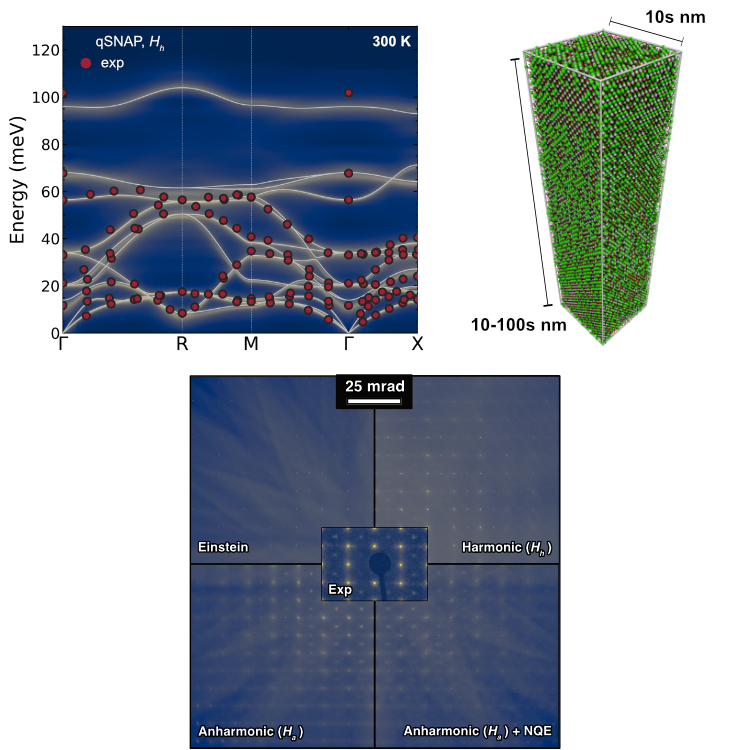
Here we investigate electron scattering simulations with thermal displacements incorporated using molecular dynamics potentials. Specifically, we explore the sensitivity of electron scattering to the phonon band structure, or more explicitly interatomic forces. Silicon serves as the model material where we introduce thermal atomic displacements via empirical and machine-learned molecular dynamics interatomic potentials and compare them to finite-temperature density functional theory interatomic forces. We demonstrate that when molecular dynamics potentials do not sufficiently reproduce the correct phonon band structure, significant errors in the simulated diffraction and image intensities can occur. Moreover, for Si, we find that multislice simulations using machine-learned interatomic potentials are more accurate than empirical ones. In addition to the selected atomic potential, we demonstrate that the sensitivity to the phonon band structure also depends on the crystal zone axis, which can be used to enhance sensitivity to thermal displacements. Finally, we provide a sensitivity analysis with angle-resolved scanning transmission electron microscopy (STEM) to enhance image sensitivity to the details of the phonon band structure.
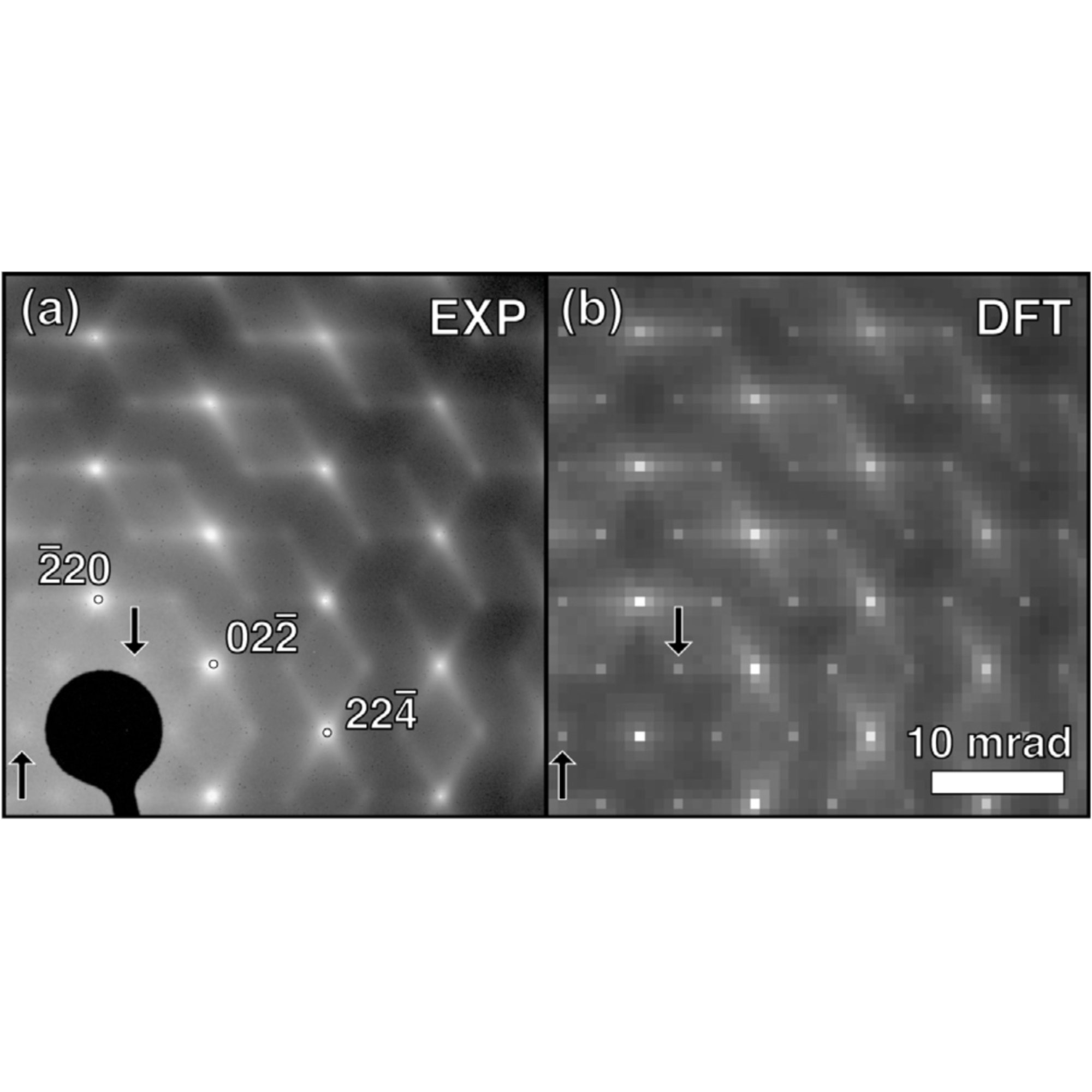
Here we investigate electron scattering simulations with thermal displacements incorporated using molecular dynamics potentials. Specifically, we explore the sensitivity of electron scattering to the phonon band structure, or more explicitly interatomic forces. Silicon serves as the model material where we introduce thermal atomic displacements via empirical and machine-learned molecular dynamics interatomic potentials and compare them to finite-temperature density functional theory interatomic forces. We demonstrate that when molecular dynamics potentials do not sufficiently reproduce the correct phonon band structure, significant errors in the simulated diffraction and image intensities can occur. Moreover, for Si, we find that multislice simulations using machine-learned interatomic potentials are more accurate than empirical ones. In addition to the selected atomic potential, we demonstrate that the sensitivity to the phonon band structure also depends on the crystal zone axis, which can be used to enhance sensitivity to thermal displacements. Finally, we provide a sensitivity analysis with angle-resolved scanning transmission electron microscopy (STEM) to enhance image sensitivity to the details of the phonon band structure.
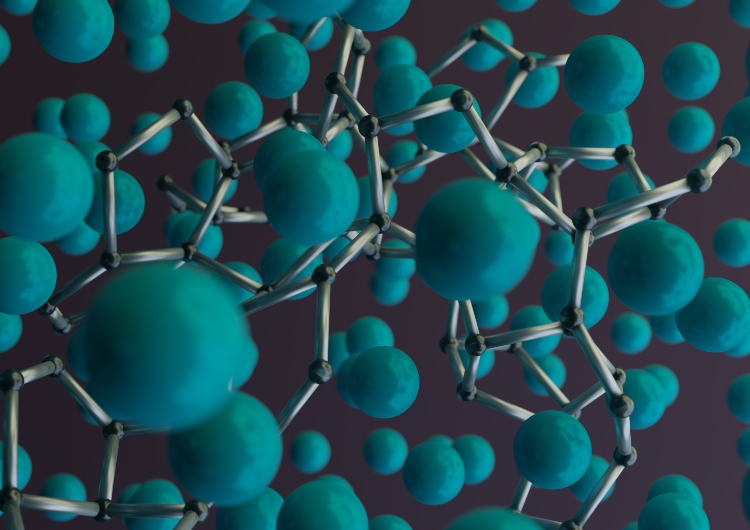
Here we investigate electron scattering simulations with thermal displacements incorporated using molecular dynamics potentials. Specifically, we explore the sensitivity of electron scattering to the phonon band structure, or more explicitly interatomic forces. Silicon serves as the model material where we introduce thermal atomic displacements via empirical and machine-learned molecular dynamics interatomic potentials and compare them to finite-temperature density functional theory interatomic forces. We demonstrate that when molecular dynamics potentials do not sufficiently reproduce the correct phonon band structure, significant errors in the simulated diffraction and image intensities can occur. Moreover, for Si, we find that multislice simulations using machine-learned interatomic potentials are more accurate than empirical ones. In addition to the selected atomic potential, we demonstrate that the sensitivity to the phonon band structure also depends on the crystal zone axis, which can be used to enhance sensitivity to thermal displacements. Finally, we provide a sensitivity analysis with angle-resolved scanning transmission electron microscopy (STEM) to enhance image sensitivity to the details of the phonon band structure.
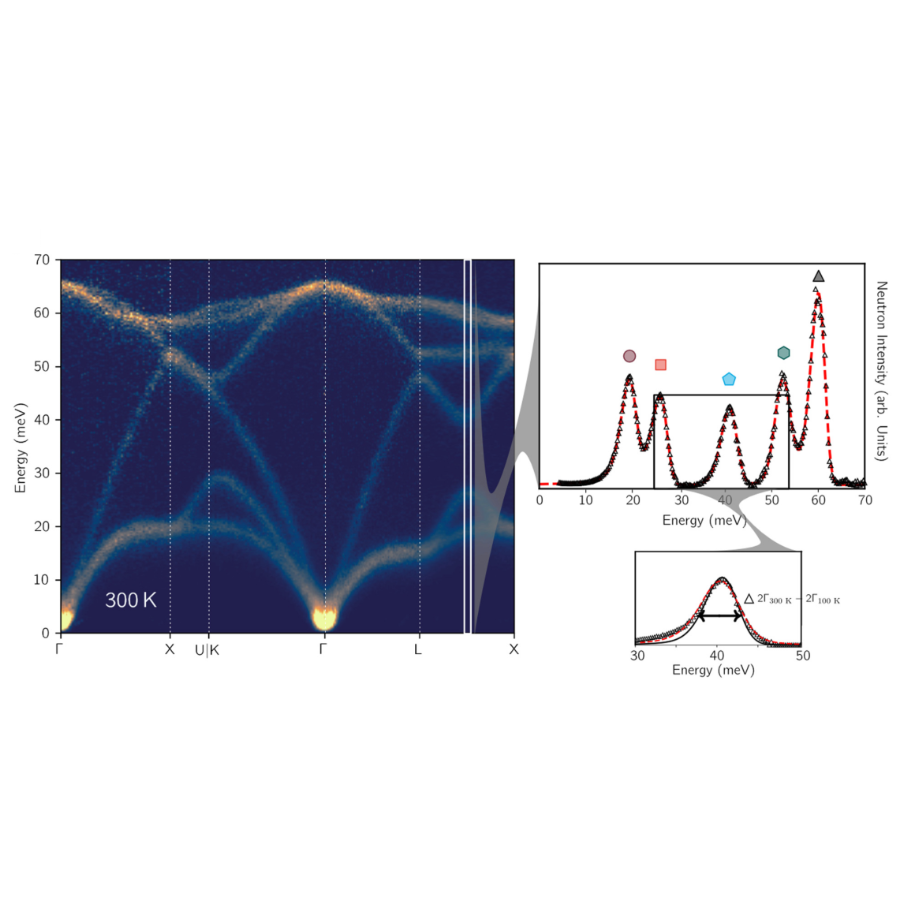
The electronic, optical and chemical properties of two-dimensional transition metal dichalcogenides strongly depend on their three-dimensional atomic structure and crystal defects. Using Re-doped MoS
2 as a model system, here we present scanning atomic electron tomography as a method to determine three-dimensional atomic positions as well as positions of crystal defects such as dopants, vacancies and ripples with a precision down to 4 pm. We measure the three-dimensional bond dis- tortion and local strain tensor induced by single dopants. By directly providing these experimental three-dimensional atomic coordinates to density functional theory, we obtain more accurate electronic band structures than derived from conventional density functional theory calculations that relies on relaxed three-dimensional atomic coordinates. We anticipate that scan- ning atomic electron tomography not only will be generally applicable to determine the three-dimensional atomic coordinates of two-dimensional materials, but also will enable ab initio calculations to better predict the physical, chemical and electronic properties of these materials.
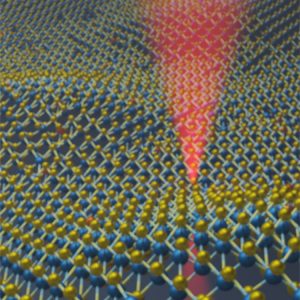
Despite the widespread use of silicon in modern technology, its peculiar thermal expansion is not well understood. Adapt- ing harmonic phonons to the specific volume at temperature, the quasiharmonic approximation, has become accepted for sim- ulating the thermal expansion, but has given ambiguous inter- pretations for microscopic mechanisms. To test atomistic mech- anisms, we performed inelastic neutron scattering experiments from 100 K to 1,500 K on a single crystal of silicon to mea- sure the changes in phonon frequencies. Our state-of-the-art ab initio calculations, which fully account for phonon anharmonic- ity and nuclear quantum effects, reproduced the measured shifts of individual phonons with temperature, whereas quasiharmonic shifts were mostly of the wrong sign. Surprisingly, the accepted quasiharmonic model was found to predict the thermal expan- sion owing to a large cancellation of contributions from individual phonons.
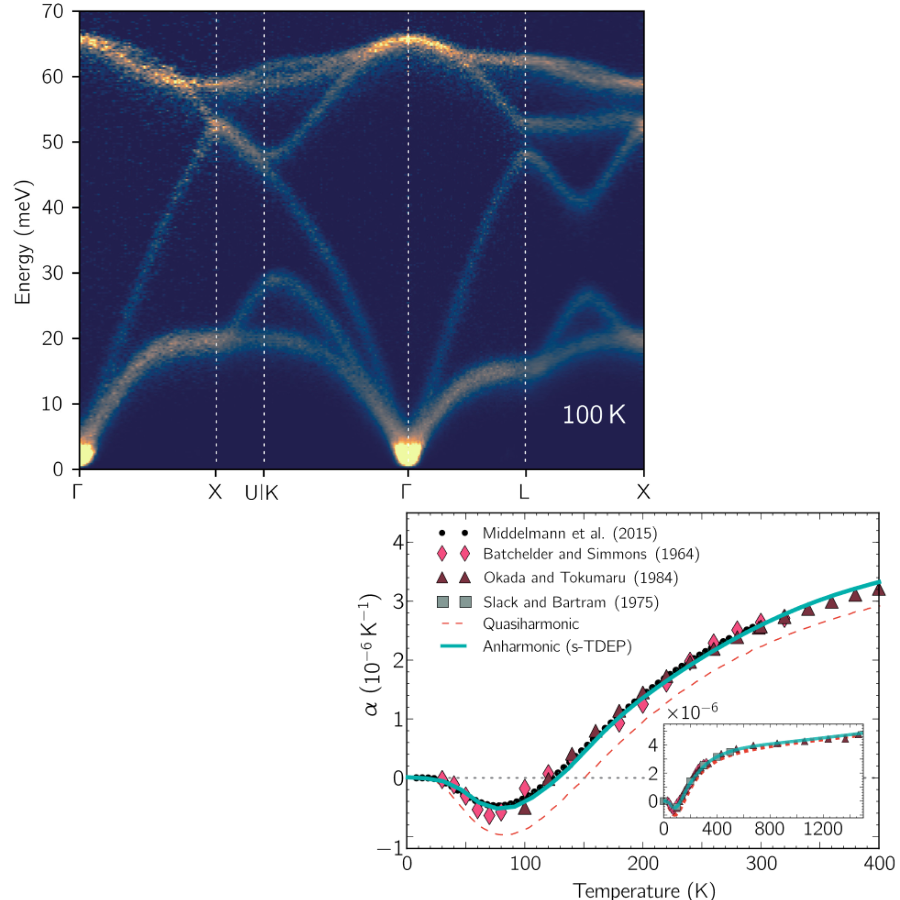
Inelastic neutron scattering was performed on silicon powder to measure the phonon density of states (DOS) from 100 to 1500 K. The mean fractional energy shifts with temperature of the modes were 〈Δεi/εiΔT〉= − 0.07, giving a mean isobaric Grüneisen parameter of + 6.95 ± 0.67, which is significantly different from the isothermal parameter of + 0.98. These large effects are beyond the predictions from quasiharmonic models using density functional theory or experimental data, demonstrating large effects from phonon anharmonicity. At 1500 K the anharmonicity contributes 0.15kB/atom to the vibrational entropy, compared to 0.03kB/atom from quasiharmonicity. Excellent agreement was found between the entropy from phonon DOS measurements and the reference NIST-JANAF thermodynamic entropy from calorimetric measurements.
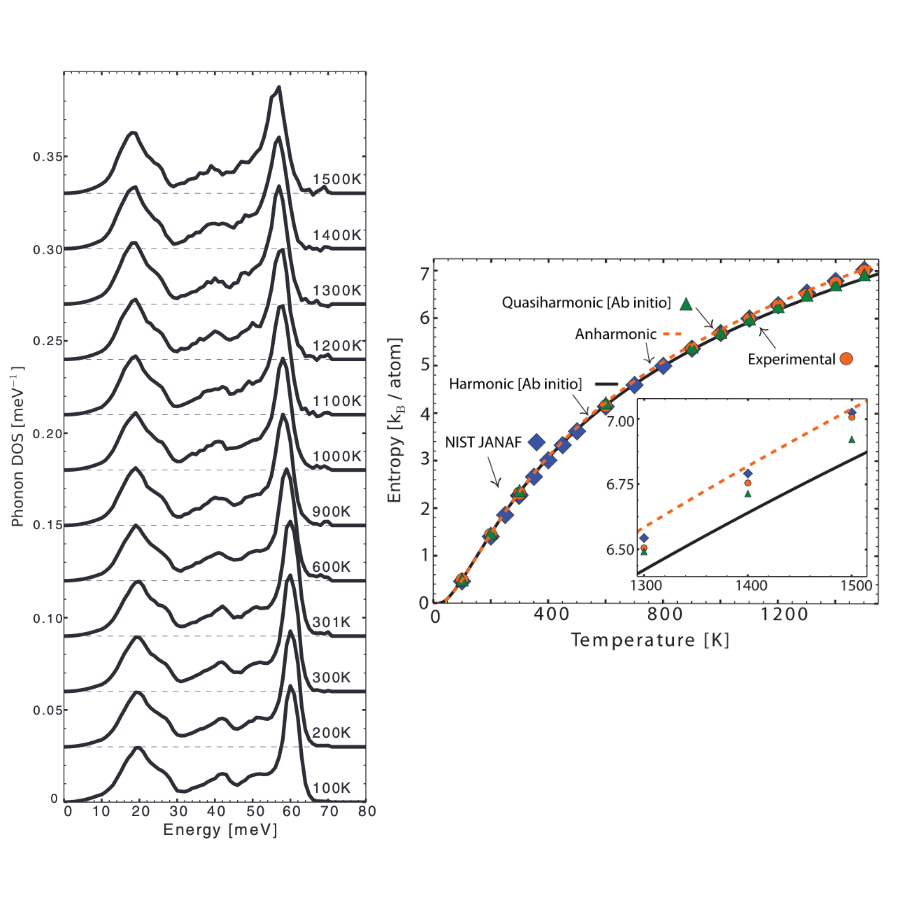
† denote equal contribution, ‡ denote corresponding authorship, bold names denote PERL Team member
D.S. Kim‡, O. Hellman, N. Shulumba, C.N. Saunders, J.Y. Lin, H.L. Smith, J.E. Herriman, J.L. Niedziela, D.L. Abernathy, C.W. Li, B. Fultz‡, Phys. Rev. B, 102, 17, 174311 (2022)
Temperature-dependent phonon lifetimes and thermal conductivity of silicon by inelastic neutron scattering and ab initio calculations
X. Tian† , D.S. Kim† , S. Yang† , C.J. Ciccarino, Y. Gong, Y. Yang, Y. Yang, B. Duschatko, Y. Yuan, P.M. Ajayan, J.C. Idrogo, P. Narang, and J. Miao, Nat. Mater., 19, 8, 867 (2020)
Correlating the three-dimensional atomic defects and electronic properties of two-dimensional transition metal dichalcogenides
H.L. Smith, C.W. Li, A. Hoff, G.R. Garrett, D.S. Kim, F.C. Yang, M.S. Lucas, T. Swan-Wood, J.Y. Lin, M.B. Stone, D.L. Abernathy, M.D. Demetriou, and B. Fultz, Phys. Rev. B, 92, 054304 (2015)